Corporate Finance Management Issues 2022
VerifiedAdded on 2022/10/18
|8
|2596
|11
AI Summary
Contribute Materials
Your contribution can guide someone’s learning journey. Share your
documents today.
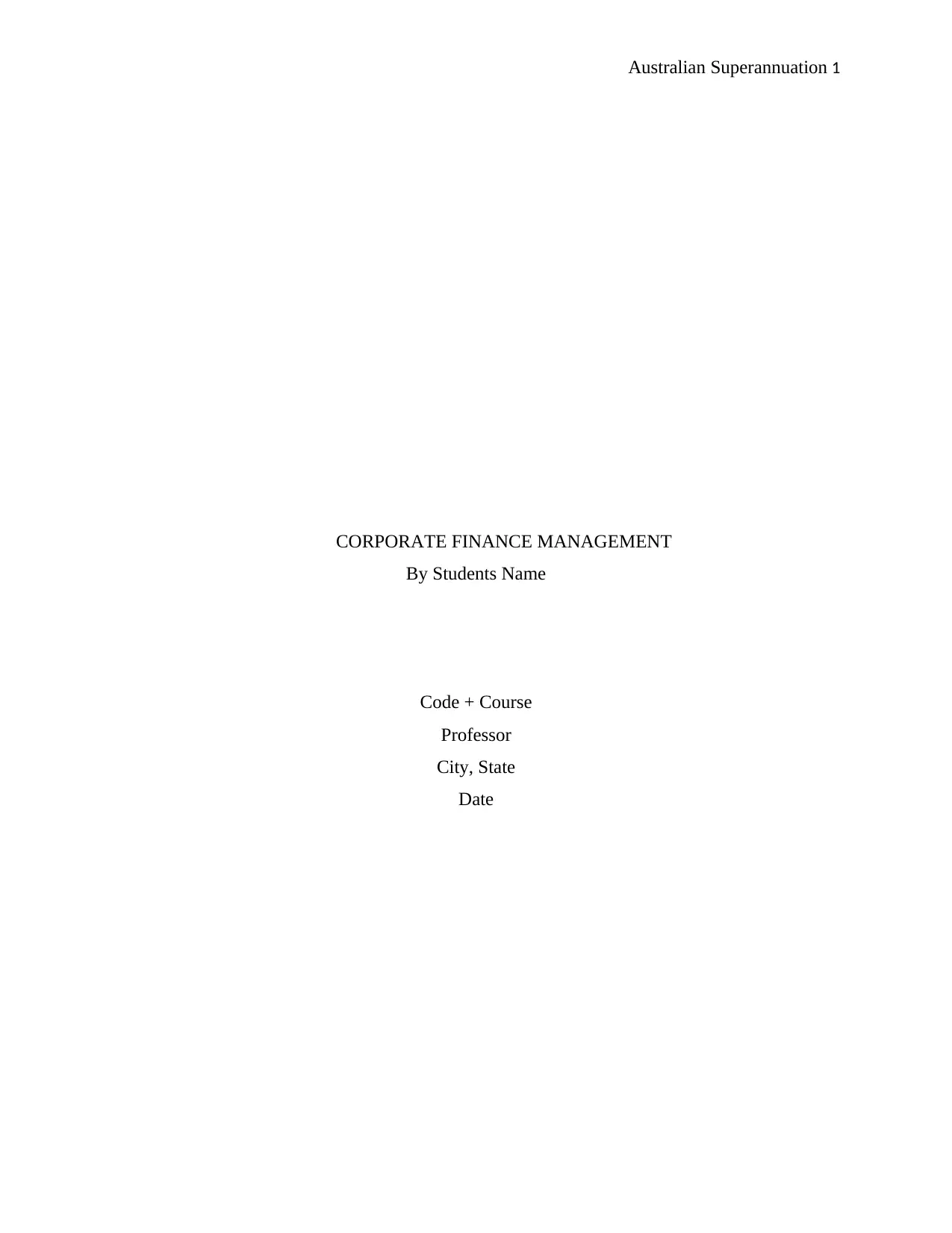
Australian Superannuation 1
CORPORATE FINANCE MANAGEMENT
By Students Name
Code + Course
Professor
City, State
Date
CORPORATE FINANCE MANAGEMENT
By Students Name
Code + Course
Professor
City, State
Date
Secure Best Marks with AI Grader
Need help grading? Try our AI Grader for instant feedback on your assignments.
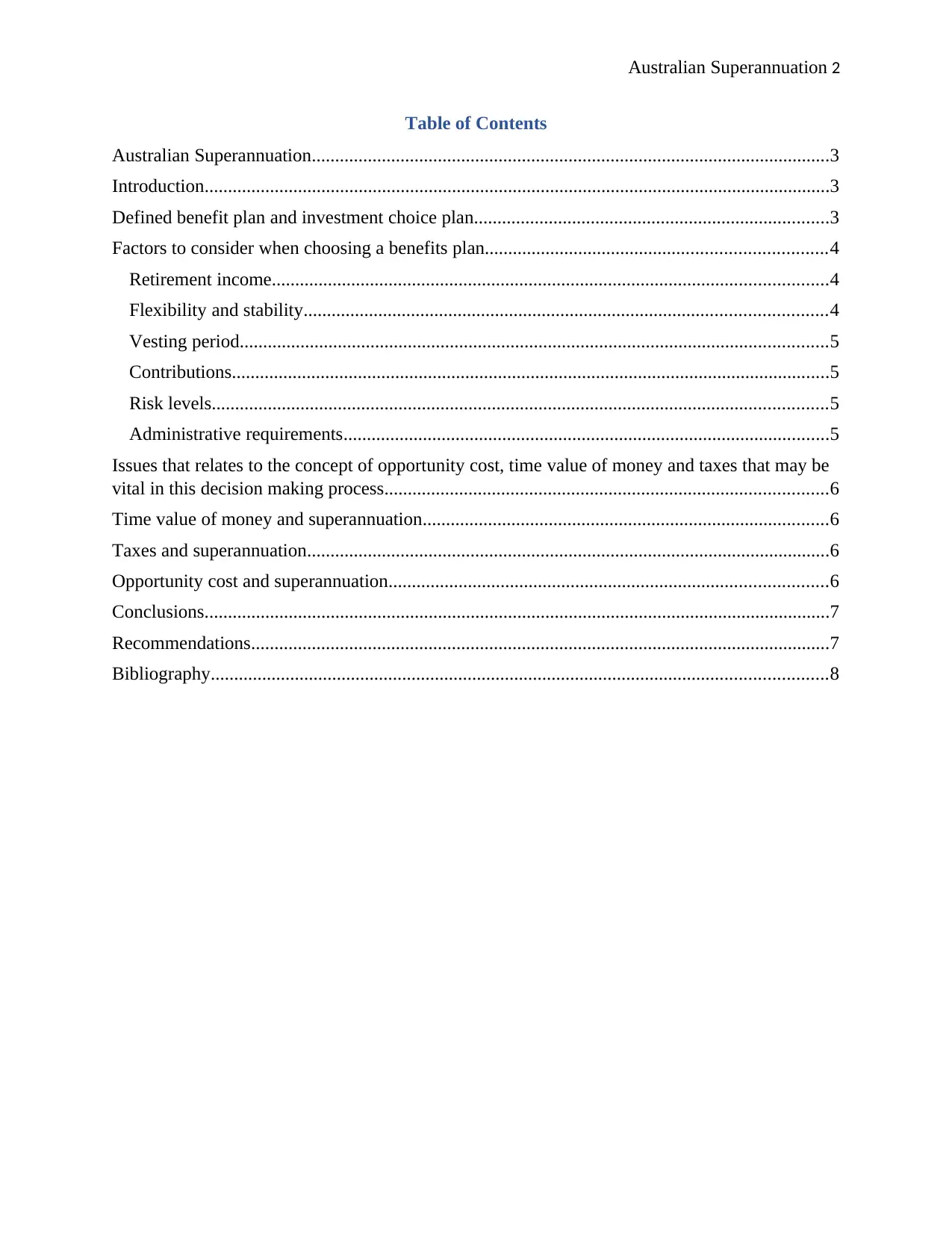
Australian Superannuation 2
Table of Contents
Australian Superannuation...............................................................................................................3
Introduction......................................................................................................................................3
Defined benefit plan and investment choice plan............................................................................3
Factors to consider when choosing a benefits plan.........................................................................4
Retirement income.......................................................................................................................4
Flexibility and stability................................................................................................................4
Vesting period..............................................................................................................................5
Contributions................................................................................................................................5
Risk levels....................................................................................................................................5
Administrative requirements........................................................................................................5
Issues that relates to the concept of opportunity cost, time value of money and taxes that may be
vital in this decision making process...............................................................................................6
Time value of money and superannuation.......................................................................................6
Taxes and superannuation................................................................................................................6
Opportunity cost and superannuation..............................................................................................6
Conclusions......................................................................................................................................7
Recommendations............................................................................................................................7
Bibliography....................................................................................................................................8
Table of Contents
Australian Superannuation...............................................................................................................3
Introduction......................................................................................................................................3
Defined benefit plan and investment choice plan............................................................................3
Factors to consider when choosing a benefits plan.........................................................................4
Retirement income.......................................................................................................................4
Flexibility and stability................................................................................................................4
Vesting period..............................................................................................................................5
Contributions................................................................................................................................5
Risk levels....................................................................................................................................5
Administrative requirements........................................................................................................5
Issues that relates to the concept of opportunity cost, time value of money and taxes that may be
vital in this decision making process...............................................................................................6
Time value of money and superannuation.......................................................................................6
Taxes and superannuation................................................................................................................6
Opportunity cost and superannuation..............................................................................................6
Conclusions......................................................................................................................................7
Recommendations............................................................................................................................7
Bibliography....................................................................................................................................8
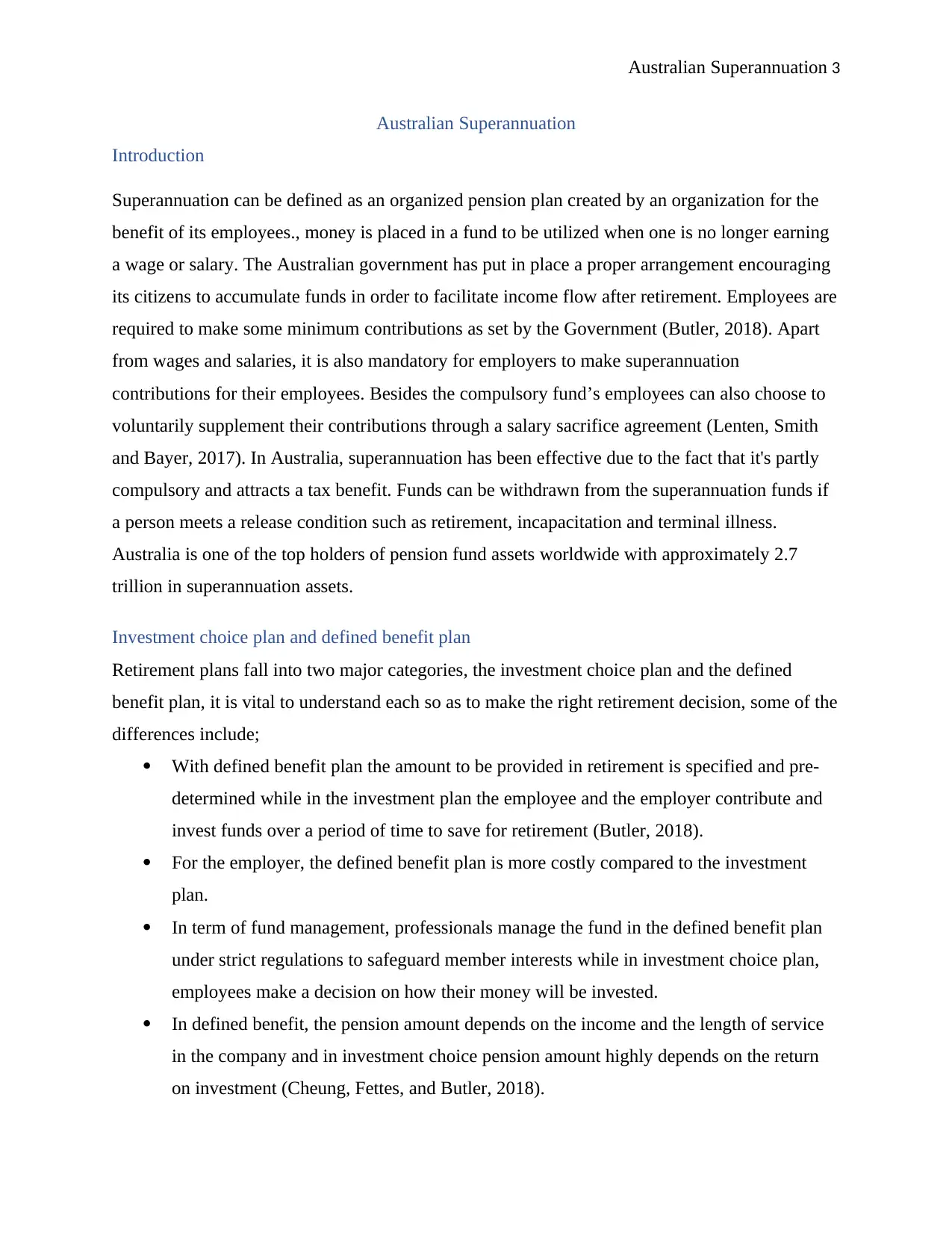
Australian Superannuation 3
Australian Superannuation
Introduction
Superannuation can be defined as an organized pension plan created by an organization for the
benefit of its employees., money is placed in a fund to be utilized when one is no longer earning
a wage or salary. The Australian government has put in place a proper arrangement encouraging
its citizens to accumulate funds in order to facilitate income flow after retirement. Employees are
required to make some minimum contributions as set by the Government (Butler, 2018). Apart
from wages and salaries, it is also mandatory for employers to make superannuation
contributions for their employees. Besides the compulsory fund’s employees can also choose to
voluntarily supplement their contributions through a salary sacrifice agreement (Lenten, Smith
and Bayer, 2017). In Australia, superannuation has been effective due to the fact that it's partly
compulsory and attracts a tax benefit. Funds can be withdrawn from the superannuation funds if
a person meets a release condition such as retirement, incapacitation and terminal illness.
Australia is one of the top holders of pension fund assets worldwide with approximately 2.7
trillion in superannuation assets.
Investment choice plan and defined benefit plan
Retirement plans fall into two major categories, the investment choice plan and the defined
benefit plan, it is vital to understand each so as to make the right retirement decision, some of the
differences include;
With defined benefit plan the amount to be provided in retirement is specified and pre-
determined while in the investment plan the employee and the employer contribute and
invest funds over a period of time to save for retirement (Butler, 2018).
For the employer, the defined benefit plan is more costly compared to the investment
plan.
In term of fund management, professionals manage the fund in the defined benefit plan
under strict regulations to safeguard member interests while in investment choice plan,
employees make a decision on how their money will be invested.
In defined benefit, the pension amount depends on the income and the length of service
in the company and in investment choice pension amount highly depends on the return
on investment (Cheung, Fettes, and Butler, 2018).
Australian Superannuation
Introduction
Superannuation can be defined as an organized pension plan created by an organization for the
benefit of its employees., money is placed in a fund to be utilized when one is no longer earning
a wage or salary. The Australian government has put in place a proper arrangement encouraging
its citizens to accumulate funds in order to facilitate income flow after retirement. Employees are
required to make some minimum contributions as set by the Government (Butler, 2018). Apart
from wages and salaries, it is also mandatory for employers to make superannuation
contributions for their employees. Besides the compulsory fund’s employees can also choose to
voluntarily supplement their contributions through a salary sacrifice agreement (Lenten, Smith
and Bayer, 2017). In Australia, superannuation has been effective due to the fact that it's partly
compulsory and attracts a tax benefit. Funds can be withdrawn from the superannuation funds if
a person meets a release condition such as retirement, incapacitation and terminal illness.
Australia is one of the top holders of pension fund assets worldwide with approximately 2.7
trillion in superannuation assets.
Investment choice plan and defined benefit plan
Retirement plans fall into two major categories, the investment choice plan and the defined
benefit plan, it is vital to understand each so as to make the right retirement decision, some of the
differences include;
With defined benefit plan the amount to be provided in retirement is specified and pre-
determined while in the investment plan the employee and the employer contribute and
invest funds over a period of time to save for retirement (Butler, 2018).
For the employer, the defined benefit plan is more costly compared to the investment
plan.
In term of fund management, professionals manage the fund in the defined benefit plan
under strict regulations to safeguard member interests while in investment choice plan,
employees make a decision on how their money will be invested.
In defined benefit, the pension amount depends on the income and the length of service
in the company and in investment choice pension amount highly depends on the return
on investment (Cheung, Fettes, and Butler, 2018).
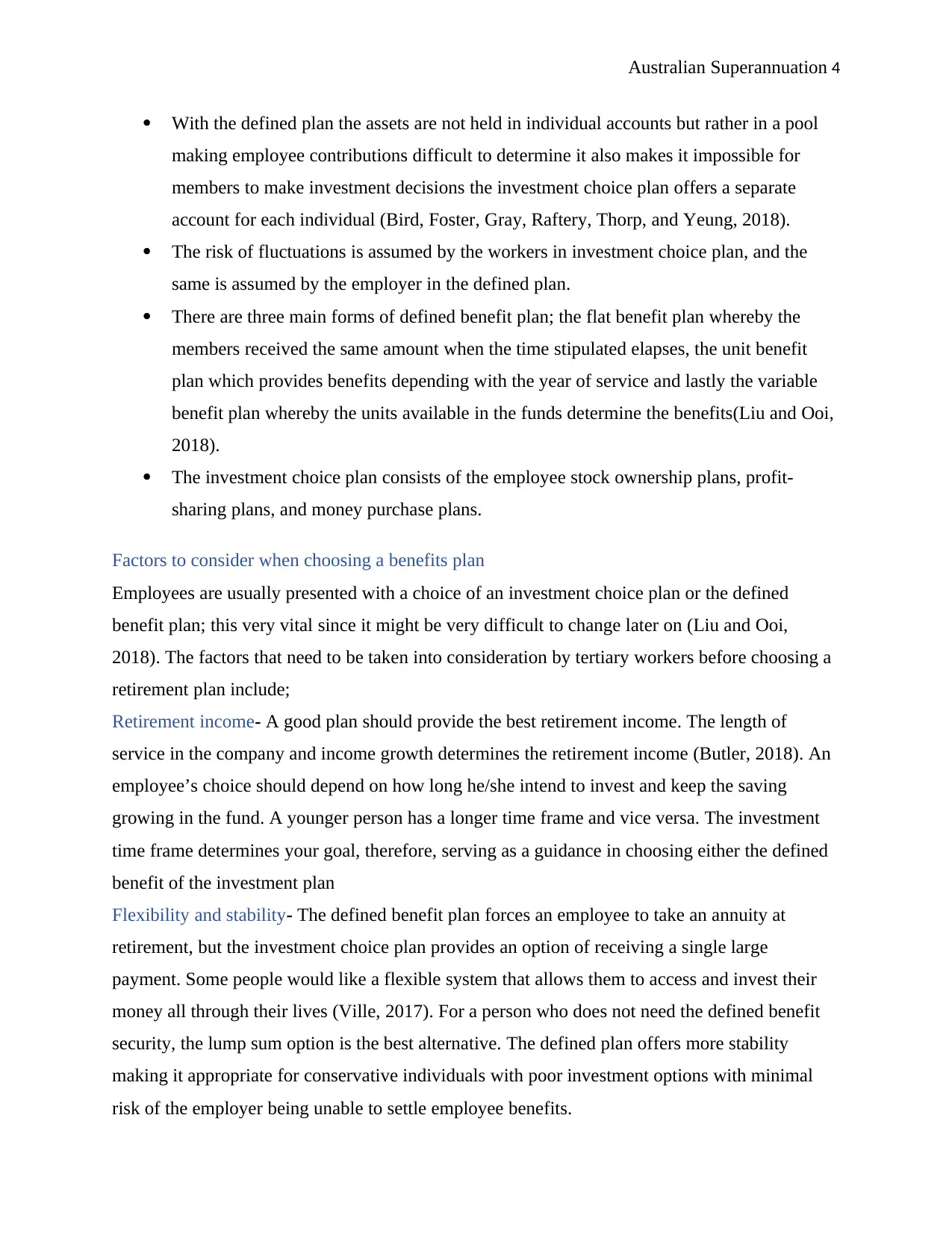
Australian Superannuation 4
With the defined plan the assets are not held in individual accounts but rather in a pool
making employee contributions difficult to determine it also makes it impossible for
members to make investment decisions the investment choice plan offers a separate
account for each individual (Bird, Foster, Gray, Raftery, Thorp, and Yeung, 2018).
The risk of fluctuations is assumed by the workers in investment choice plan, and the
same is assumed by the employer in the defined plan.
There are three main forms of defined benefit plan; the flat benefit plan whereby the
members received the same amount when the time stipulated elapses, the unit benefit
plan which provides benefits depending with the year of service and lastly the variable
benefit plan whereby the units available in the funds determine the benefits(Liu and Ooi,
2018).
The investment choice plan consists of the employee stock ownership plans, profit-
sharing plans, and money purchase plans.
Factors to consider when choosing a benefits plan
Employees are usually presented with a choice of an investment choice plan or the defined
benefit plan; this very vital since it might be very difficult to change later on (Liu and Ooi,
2018). The factors that need to be taken into consideration by tertiary workers before choosing a
retirement plan include;
Retirement income- A good plan should provide the best retirement income. The length of
service in the company and income growth determines the retirement income (Butler, 2018). An
employee’s choice should depend on how long he/she intend to invest and keep the saving
growing in the fund. A younger person has a longer time frame and vice versa. The investment
time frame determines your goal, therefore, serving as a guidance in choosing either the defined
benefit of the investment plan
Flexibility and stability- The defined benefit plan forces an employee to take an annuity at
retirement, but the investment choice plan provides an option of receiving a single large
payment. Some people would like a flexible system that allows them to access and invest their
money all through their lives (Ville, 2017). For a person who does not need the defined benefit
security, the lump sum option is the best alternative. The defined plan offers more stability
making it appropriate for conservative individuals with poor investment options with minimal
risk of the employer being unable to settle employee benefits.
With the defined plan the assets are not held in individual accounts but rather in a pool
making employee contributions difficult to determine it also makes it impossible for
members to make investment decisions the investment choice plan offers a separate
account for each individual (Bird, Foster, Gray, Raftery, Thorp, and Yeung, 2018).
The risk of fluctuations is assumed by the workers in investment choice plan, and the
same is assumed by the employer in the defined plan.
There are three main forms of defined benefit plan; the flat benefit plan whereby the
members received the same amount when the time stipulated elapses, the unit benefit
plan which provides benefits depending with the year of service and lastly the variable
benefit plan whereby the units available in the funds determine the benefits(Liu and Ooi,
2018).
The investment choice plan consists of the employee stock ownership plans, profit-
sharing plans, and money purchase plans.
Factors to consider when choosing a benefits plan
Employees are usually presented with a choice of an investment choice plan or the defined
benefit plan; this very vital since it might be very difficult to change later on (Liu and Ooi,
2018). The factors that need to be taken into consideration by tertiary workers before choosing a
retirement plan include;
Retirement income- A good plan should provide the best retirement income. The length of
service in the company and income growth determines the retirement income (Butler, 2018). An
employee’s choice should depend on how long he/she intend to invest and keep the saving
growing in the fund. A younger person has a longer time frame and vice versa. The investment
time frame determines your goal, therefore, serving as a guidance in choosing either the defined
benefit of the investment plan
Flexibility and stability- The defined benefit plan forces an employee to take an annuity at
retirement, but the investment choice plan provides an option of receiving a single large
payment. Some people would like a flexible system that allows them to access and invest their
money all through their lives (Ville, 2017). For a person who does not need the defined benefit
security, the lump sum option is the best alternative. The defined plan offers more stability
making it appropriate for conservative individuals with poor investment options with minimal
risk of the employer being unable to settle employee benefits.
Secure Best Marks with AI Grader
Need help grading? Try our AI Grader for instant feedback on your assignments.
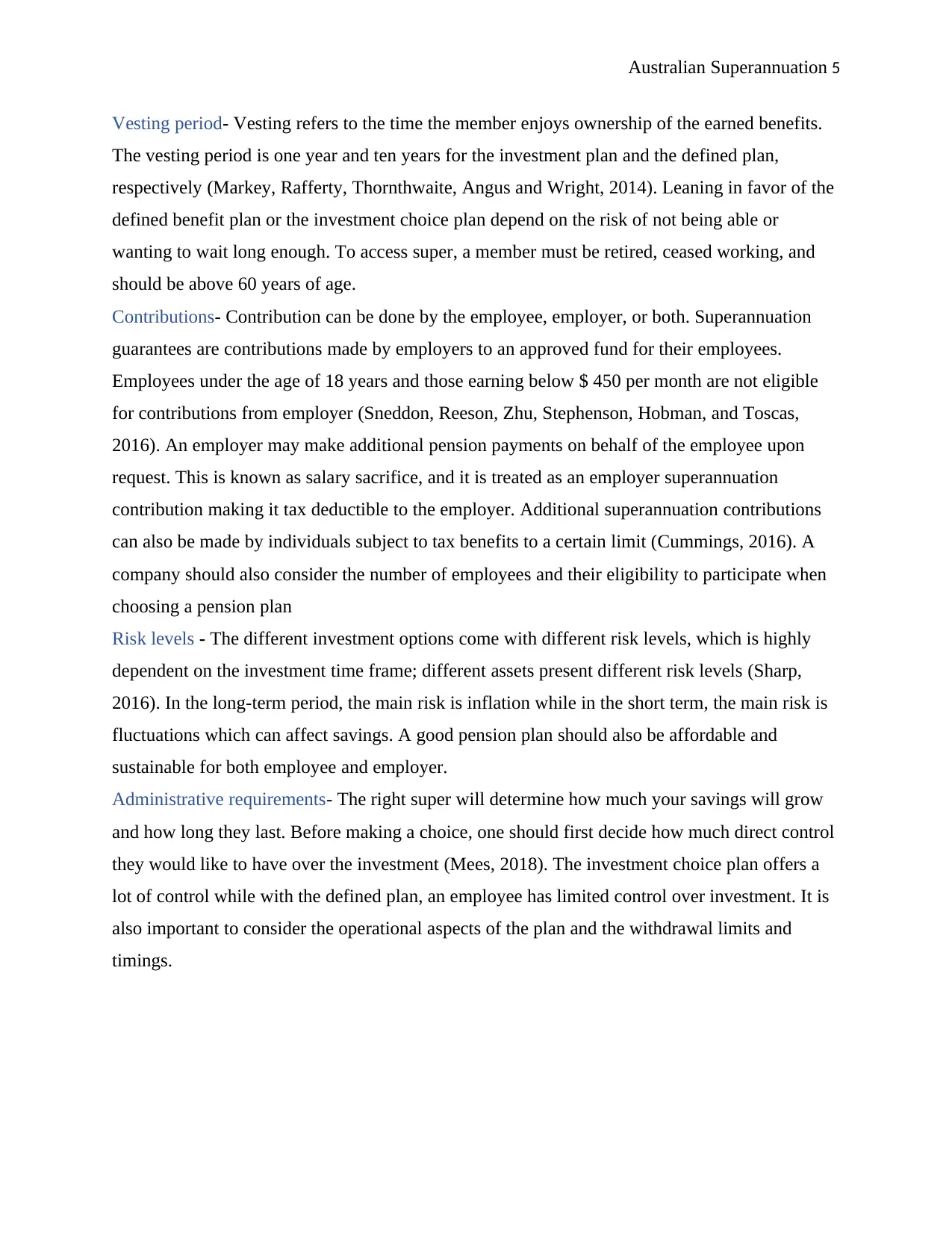
Australian Superannuation 5
Vesting period- Vesting refers to the time the member enjoys ownership of the earned benefits.
The vesting period is one year and ten years for the investment plan and the defined plan,
respectively (Markey, Rafferty, Thornthwaite, Angus and Wright, 2014). Leaning in favor of the
defined benefit plan or the investment choice plan depend on the risk of not being able or
wanting to wait long enough. To access super, a member must be retired, ceased working, and
should be above 60 years of age.
Contributions- Contribution can be done by the employee, employer, or both. Superannuation
guarantees are contributions made by employers to an approved fund for their employees.
Employees under the age of 18 years and those earning below $ 450 per month are not eligible
for contributions from employer (Sneddon, Reeson, Zhu, Stephenson, Hobman, and Toscas,
2016). An employer may make additional pension payments on behalf of the employee upon
request. This is known as salary sacrifice, and it is treated as an employer superannuation
contribution making it tax deductible to the employer. Additional superannuation contributions
can also be made by individuals subject to tax benefits to a certain limit (Cummings, 2016). A
company should also consider the number of employees and their eligibility to participate when
choosing a pension plan
Risk levels - The different investment options come with different risk levels, which is highly
dependent on the investment time frame; different assets present different risk levels (Sharp,
2016). In the long-term period, the main risk is inflation while in the short term, the main risk is
fluctuations which can affect savings. A good pension plan should also be affordable and
sustainable for both employee and employer.
Administrative requirements- The right super will determine how much your savings will grow
and how long they last. Before making a choice, one should first decide how much direct control
they would like to have over the investment (Mees, 2018). The investment choice plan offers a
lot of control while with the defined plan, an employee has limited control over investment. It is
also important to consider the operational aspects of the plan and the withdrawal limits and
timings.
Vesting period- Vesting refers to the time the member enjoys ownership of the earned benefits.
The vesting period is one year and ten years for the investment plan and the defined plan,
respectively (Markey, Rafferty, Thornthwaite, Angus and Wright, 2014). Leaning in favor of the
defined benefit plan or the investment choice plan depend on the risk of not being able or
wanting to wait long enough. To access super, a member must be retired, ceased working, and
should be above 60 years of age.
Contributions- Contribution can be done by the employee, employer, or both. Superannuation
guarantees are contributions made by employers to an approved fund for their employees.
Employees under the age of 18 years and those earning below $ 450 per month are not eligible
for contributions from employer (Sneddon, Reeson, Zhu, Stephenson, Hobman, and Toscas,
2016). An employer may make additional pension payments on behalf of the employee upon
request. This is known as salary sacrifice, and it is treated as an employer superannuation
contribution making it tax deductible to the employer. Additional superannuation contributions
can also be made by individuals subject to tax benefits to a certain limit (Cummings, 2016). A
company should also consider the number of employees and their eligibility to participate when
choosing a pension plan
Risk levels - The different investment options come with different risk levels, which is highly
dependent on the investment time frame; different assets present different risk levels (Sharp,
2016). In the long-term period, the main risk is inflation while in the short term, the main risk is
fluctuations which can affect savings. A good pension plan should also be affordable and
sustainable for both employee and employer.
Administrative requirements- The right super will determine how much your savings will grow
and how long they last. Before making a choice, one should first decide how much direct control
they would like to have over the investment (Mees, 2018). The investment choice plan offers a
lot of control while with the defined plan, an employee has limited control over investment. It is
also important to consider the operational aspects of the plan and the withdrawal limits and
timings.
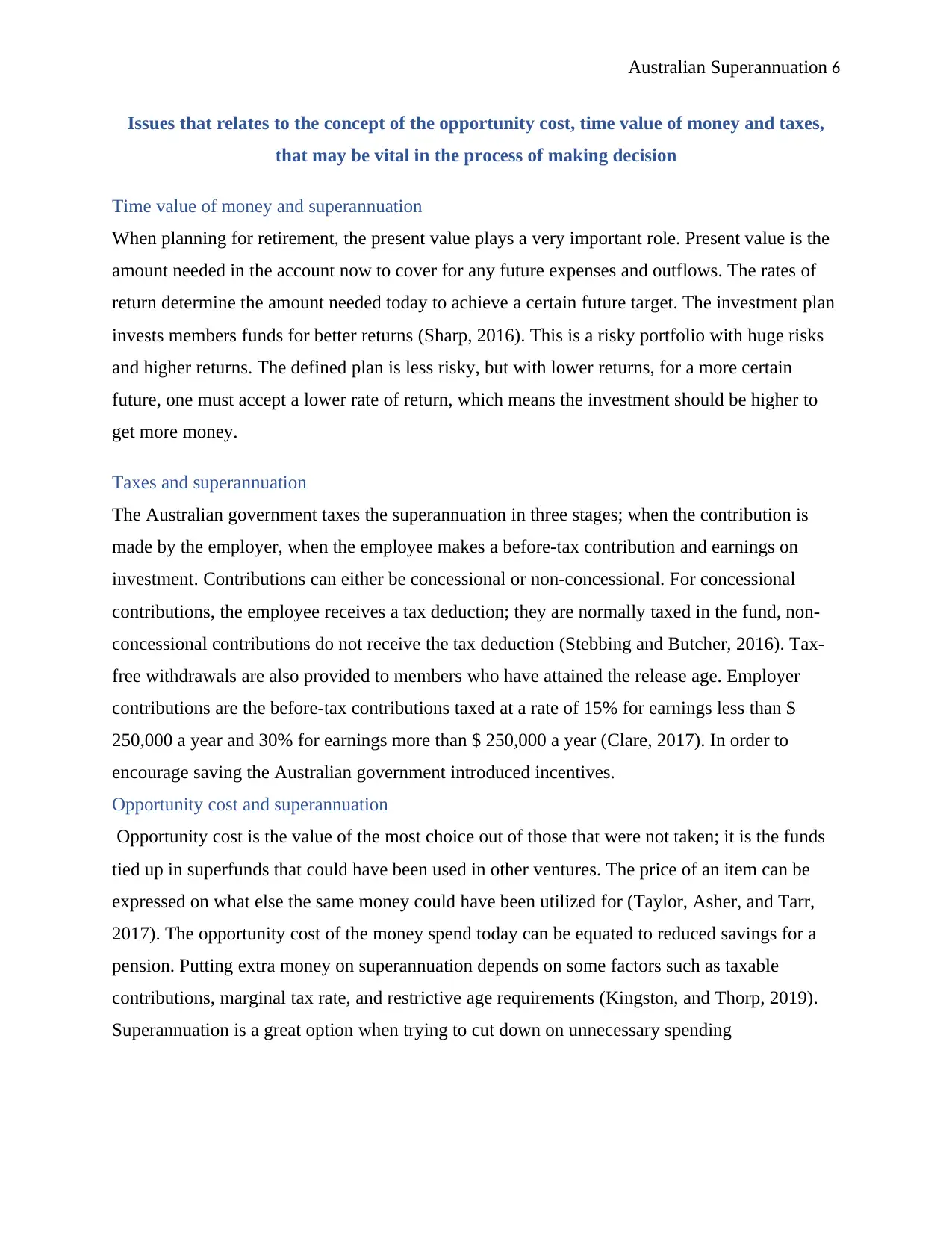
Australian Superannuation 6
Issues that relates to the concept of the opportunity cost, time value of money and taxes,
that may be vital in the process of making decision
Time value of money and superannuation
When planning for retirement, the present value plays a very important role. Present value is the
amount needed in the account now to cover for any future expenses and outflows. The rates of
return determine the amount needed today to achieve a certain future target. The investment plan
invests members funds for better returns (Sharp, 2016). This is a risky portfolio with huge risks
and higher returns. The defined plan is less risky, but with lower returns, for a more certain
future, one must accept a lower rate of return, which means the investment should be higher to
get more money.
Taxes and superannuation
The Australian government taxes the superannuation in three stages; when the contribution is
made by the employer, when the employee makes a before-tax contribution and earnings on
investment. Contributions can either be concessional or non-concessional. For concessional
contributions, the employee receives a tax deduction; they are normally taxed in the fund, non-
concessional contributions do not receive the tax deduction (Stebbing and Butcher, 2016). Tax-
free withdrawals are also provided to members who have attained the release age. Employer
contributions are the before-tax contributions taxed at a rate of 15% for earnings less than $
250,000 a year and 30% for earnings more than $ 250,000 a year (Clare, 2017). In order to
encourage saving the Australian government introduced incentives.
Opportunity cost and superannuation
Opportunity cost is the value of the most choice out of those that were not taken; it is the funds
tied up in superfunds that could have been used in other ventures. The price of an item can be
expressed on what else the same money could have been utilized for (Taylor, Asher, and Tarr,
2017). The opportunity cost of the money spend today can be equated to reduced savings for a
pension. Putting extra money on superannuation depends on some factors such as taxable
contributions, marginal tax rate, and restrictive age requirements (Kingston, and Thorp, 2019).
Superannuation is a great option when trying to cut down on unnecessary spending
Issues that relates to the concept of the opportunity cost, time value of money and taxes,
that may be vital in the process of making decision
Time value of money and superannuation
When planning for retirement, the present value plays a very important role. Present value is the
amount needed in the account now to cover for any future expenses and outflows. The rates of
return determine the amount needed today to achieve a certain future target. The investment plan
invests members funds for better returns (Sharp, 2016). This is a risky portfolio with huge risks
and higher returns. The defined plan is less risky, but with lower returns, for a more certain
future, one must accept a lower rate of return, which means the investment should be higher to
get more money.
Taxes and superannuation
The Australian government taxes the superannuation in three stages; when the contribution is
made by the employer, when the employee makes a before-tax contribution and earnings on
investment. Contributions can either be concessional or non-concessional. For concessional
contributions, the employee receives a tax deduction; they are normally taxed in the fund, non-
concessional contributions do not receive the tax deduction (Stebbing and Butcher, 2016). Tax-
free withdrawals are also provided to members who have attained the release age. Employer
contributions are the before-tax contributions taxed at a rate of 15% for earnings less than $
250,000 a year and 30% for earnings more than $ 250,000 a year (Clare, 2017). In order to
encourage saving the Australian government introduced incentives.
Opportunity cost and superannuation
Opportunity cost is the value of the most choice out of those that were not taken; it is the funds
tied up in superfunds that could have been used in other ventures. The price of an item can be
expressed on what else the same money could have been utilized for (Taylor, Asher, and Tarr,
2017). The opportunity cost of the money spend today can be equated to reduced savings for a
pension. Putting extra money on superannuation depends on some factors such as taxable
contributions, marginal tax rate, and restrictive age requirements (Kingston, and Thorp, 2019).
Superannuation is a great option when trying to cut down on unnecessary spending
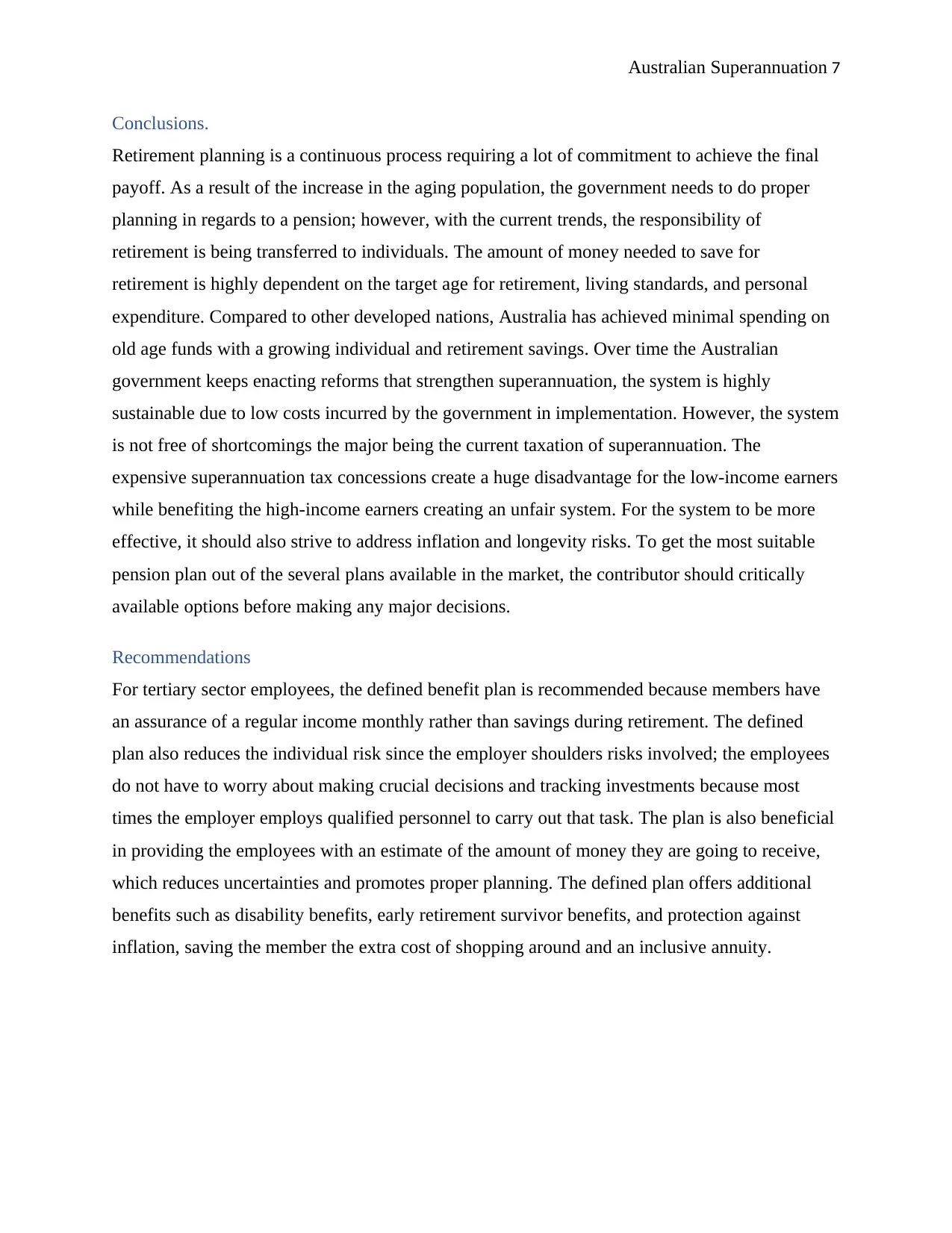
Australian Superannuation 7
Conclusions.
Retirement planning is a continuous process requiring a lot of commitment to achieve the final
payoff. As a result of the increase in the aging population, the government needs to do proper
planning in regards to a pension; however, with the current trends, the responsibility of
retirement is being transferred to individuals. The amount of money needed to save for
retirement is highly dependent on the target age for retirement, living standards, and personal
expenditure. Compared to other developed nations, Australia has achieved minimal spending on
old age funds with a growing individual and retirement savings. Over time the Australian
government keeps enacting reforms that strengthen superannuation, the system is highly
sustainable due to low costs incurred by the government in implementation. However, the system
is not free of shortcomings the major being the current taxation of superannuation. The
expensive superannuation tax concessions create a huge disadvantage for the low-income earners
while benefiting the high-income earners creating an unfair system. For the system to be more
effective, it should also strive to address inflation and longevity risks. To get the most suitable
pension plan out of the several plans available in the market, the contributor should critically
available options before making any major decisions.
Recommendations
For tertiary sector employees, the defined benefit plan is recommended because members have
an assurance of a regular income monthly rather than savings during retirement. The defined
plan also reduces the individual risk since the employer shoulders risks involved; the employees
do not have to worry about making crucial decisions and tracking investments because most
times the employer employs qualified personnel to carry out that task. The plan is also beneficial
in providing the employees with an estimate of the amount of money they are going to receive,
which reduces uncertainties and promotes proper planning. The defined plan offers additional
benefits such as disability benefits, early retirement survivor benefits, and protection against
inflation, saving the member the extra cost of shopping around and an inclusive annuity.
Conclusions.
Retirement planning is a continuous process requiring a lot of commitment to achieve the final
payoff. As a result of the increase in the aging population, the government needs to do proper
planning in regards to a pension; however, with the current trends, the responsibility of
retirement is being transferred to individuals. The amount of money needed to save for
retirement is highly dependent on the target age for retirement, living standards, and personal
expenditure. Compared to other developed nations, Australia has achieved minimal spending on
old age funds with a growing individual and retirement savings. Over time the Australian
government keeps enacting reforms that strengthen superannuation, the system is highly
sustainable due to low costs incurred by the government in implementation. However, the system
is not free of shortcomings the major being the current taxation of superannuation. The
expensive superannuation tax concessions create a huge disadvantage for the low-income earners
while benefiting the high-income earners creating an unfair system. For the system to be more
effective, it should also strive to address inflation and longevity risks. To get the most suitable
pension plan out of the several plans available in the market, the contributor should critically
available options before making any major decisions.
Recommendations
For tertiary sector employees, the defined benefit plan is recommended because members have
an assurance of a regular income monthly rather than savings during retirement. The defined
plan also reduces the individual risk since the employer shoulders risks involved; the employees
do not have to worry about making crucial decisions and tracking investments because most
times the employer employs qualified personnel to carry out that task. The plan is also beneficial
in providing the employees with an estimate of the amount of money they are going to receive,
which reduces uncertainties and promotes proper planning. The defined plan offers additional
benefits such as disability benefits, early retirement survivor benefits, and protection against
inflation, saving the member the extra cost of shopping around and an inclusive annuity.
Paraphrase This Document
Need a fresh take? Get an instant paraphrase of this document with our AI Paraphraser
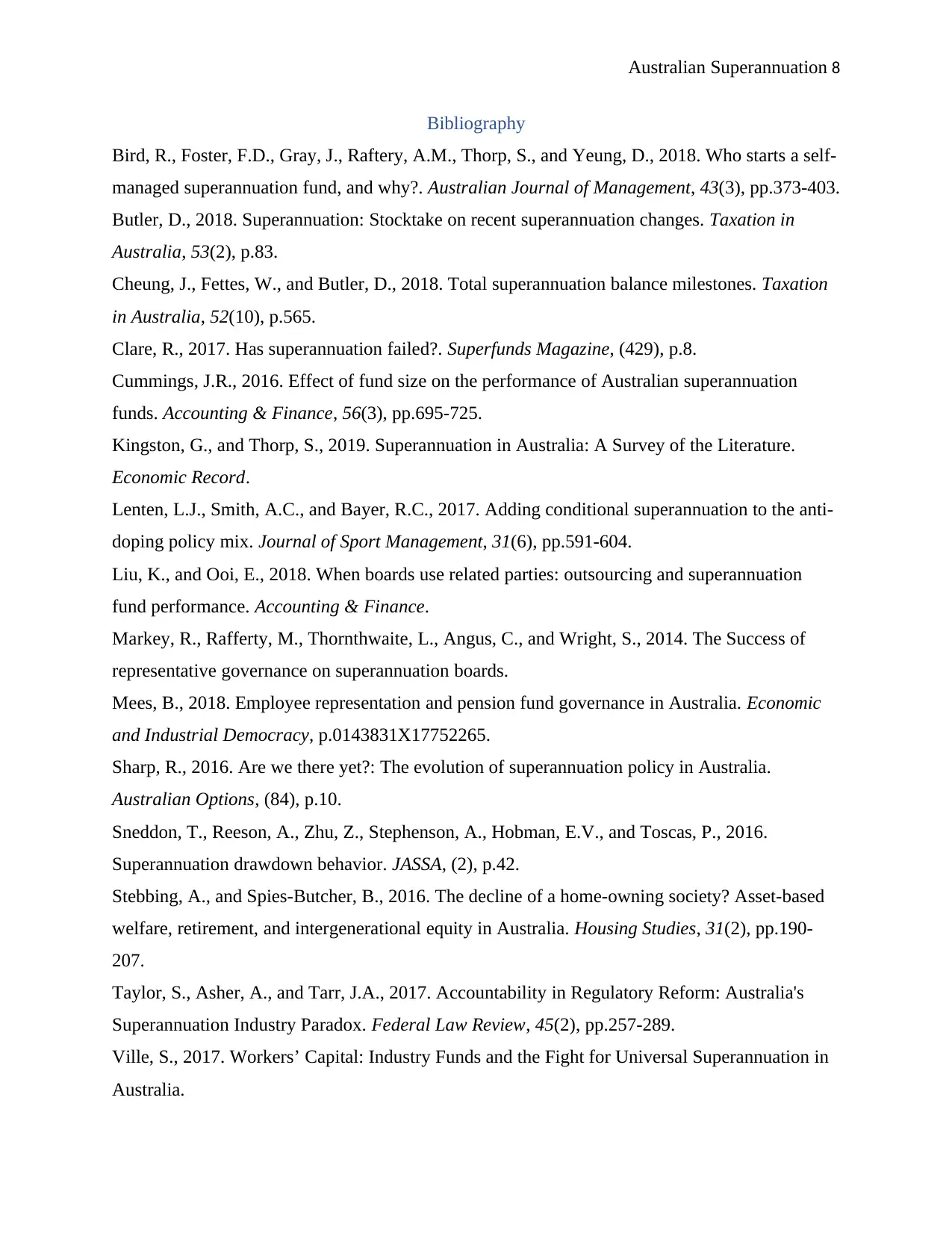
Australian Superannuation 8
Bibliography
Bird, R., Foster, F.D., Gray, J., Raftery, A.M., Thorp, S., and Yeung, D., 2018. Who starts a self-
managed superannuation fund, and why?. Australian Journal of Management, 43(3), pp.373-403.
Butler, D., 2018. Superannuation: Stocktake on recent superannuation changes. Taxation in
Australia, 53(2), p.83.
Cheung, J., Fettes, W., and Butler, D., 2018. Total superannuation balance milestones. Taxation
in Australia, 52(10), p.565.
Clare, R., 2017. Has superannuation failed?. Superfunds Magazine, (429), p.8.
Cummings, J.R., 2016. Effect of fund size on the performance of Australian superannuation
funds. Accounting & Finance, 56(3), pp.695-725.
Kingston, G., and Thorp, S., 2019. Superannuation in Australia: A Survey of the Literature.
Economic Record.
Lenten, L.J., Smith, A.C., and Bayer, R.C., 2017. Adding conditional superannuation to the anti-
doping policy mix. Journal of Sport Management, 31(6), pp.591-604.
Liu, K., and Ooi, E., 2018. When boards use related parties: outsourcing and superannuation
fund performance. Accounting & Finance.
Markey, R., Rafferty, M., Thornthwaite, L., Angus, C., and Wright, S., 2014. The Success of
representative governance on superannuation boards.
Mees, B., 2018. Employee representation and pension fund governance in Australia. Economic
and Industrial Democracy, p.0143831X17752265.
Sharp, R., 2016. Are we there yet?: The evolution of superannuation policy in Australia.
Australian Options, (84), p.10.
Sneddon, T., Reeson, A., Zhu, Z., Stephenson, A., Hobman, E.V., and Toscas, P., 2016.
Superannuation drawdown behavior. JASSA, (2), p.42.
Stebbing, A., and Spies-Butcher, B., 2016. The decline of a home-owning society? Asset-based
welfare, retirement, and intergenerational equity in Australia. Housing Studies, 31(2), pp.190-
207.
Taylor, S., Asher, A., and Tarr, J.A., 2017. Accountability in Regulatory Reform: Australia's
Superannuation Industry Paradox. Federal Law Review, 45(2), pp.257-289.
Ville, S., 2017. Workers’ Capital: Industry Funds and the Fight for Universal Superannuation in
Australia.
Bibliography
Bird, R., Foster, F.D., Gray, J., Raftery, A.M., Thorp, S., and Yeung, D., 2018. Who starts a self-
managed superannuation fund, and why?. Australian Journal of Management, 43(3), pp.373-403.
Butler, D., 2018. Superannuation: Stocktake on recent superannuation changes. Taxation in
Australia, 53(2), p.83.
Cheung, J., Fettes, W., and Butler, D., 2018. Total superannuation balance milestones. Taxation
in Australia, 52(10), p.565.
Clare, R., 2017. Has superannuation failed?. Superfunds Magazine, (429), p.8.
Cummings, J.R., 2016. Effect of fund size on the performance of Australian superannuation
funds. Accounting & Finance, 56(3), pp.695-725.
Kingston, G., and Thorp, S., 2019. Superannuation in Australia: A Survey of the Literature.
Economic Record.
Lenten, L.J., Smith, A.C., and Bayer, R.C., 2017. Adding conditional superannuation to the anti-
doping policy mix. Journal of Sport Management, 31(6), pp.591-604.
Liu, K., and Ooi, E., 2018. When boards use related parties: outsourcing and superannuation
fund performance. Accounting & Finance.
Markey, R., Rafferty, M., Thornthwaite, L., Angus, C., and Wright, S., 2014. The Success of
representative governance on superannuation boards.
Mees, B., 2018. Employee representation and pension fund governance in Australia. Economic
and Industrial Democracy, p.0143831X17752265.
Sharp, R., 2016. Are we there yet?: The evolution of superannuation policy in Australia.
Australian Options, (84), p.10.
Sneddon, T., Reeson, A., Zhu, Z., Stephenson, A., Hobman, E.V., and Toscas, P., 2016.
Superannuation drawdown behavior. JASSA, (2), p.42.
Stebbing, A., and Spies-Butcher, B., 2016. The decline of a home-owning society? Asset-based
welfare, retirement, and intergenerational equity in Australia. Housing Studies, 31(2), pp.190-
207.
Taylor, S., Asher, A., and Tarr, J.A., 2017. Accountability in Regulatory Reform: Australia's
Superannuation Industry Paradox. Federal Law Review, 45(2), pp.257-289.
Ville, S., 2017. Workers’ Capital: Industry Funds and the Fight for Universal Superannuation in
Australia.
1 out of 8
Related Documents
Your All-in-One AI-Powered Toolkit for Academic Success.
+13062052269
info@desklib.com
Available 24*7 on WhatsApp / Email
![[object Object]](/_next/static/media/star-bottom.7253800d.svg)
Unlock your academic potential
© 2024 | Zucol Services PVT LTD | All rights reserved.





